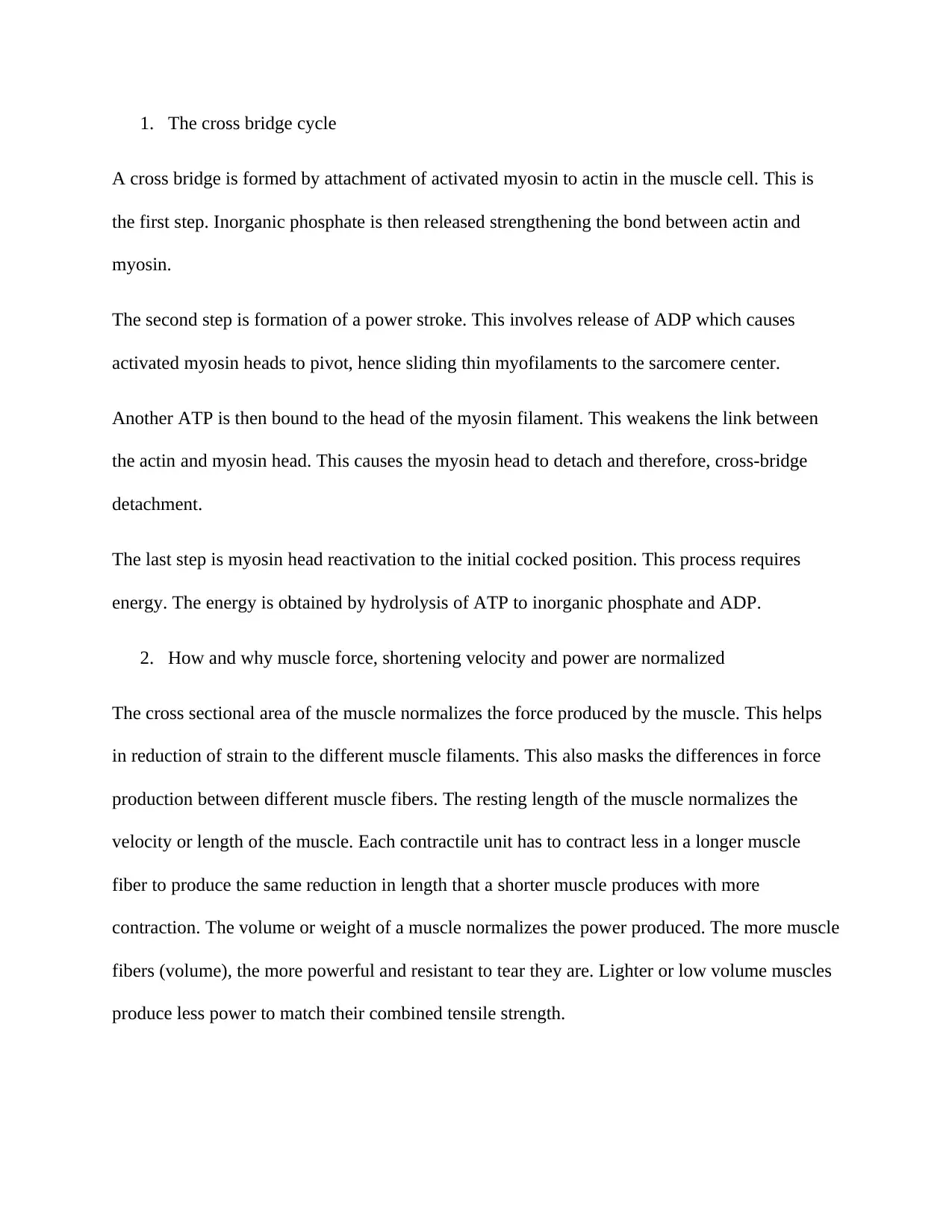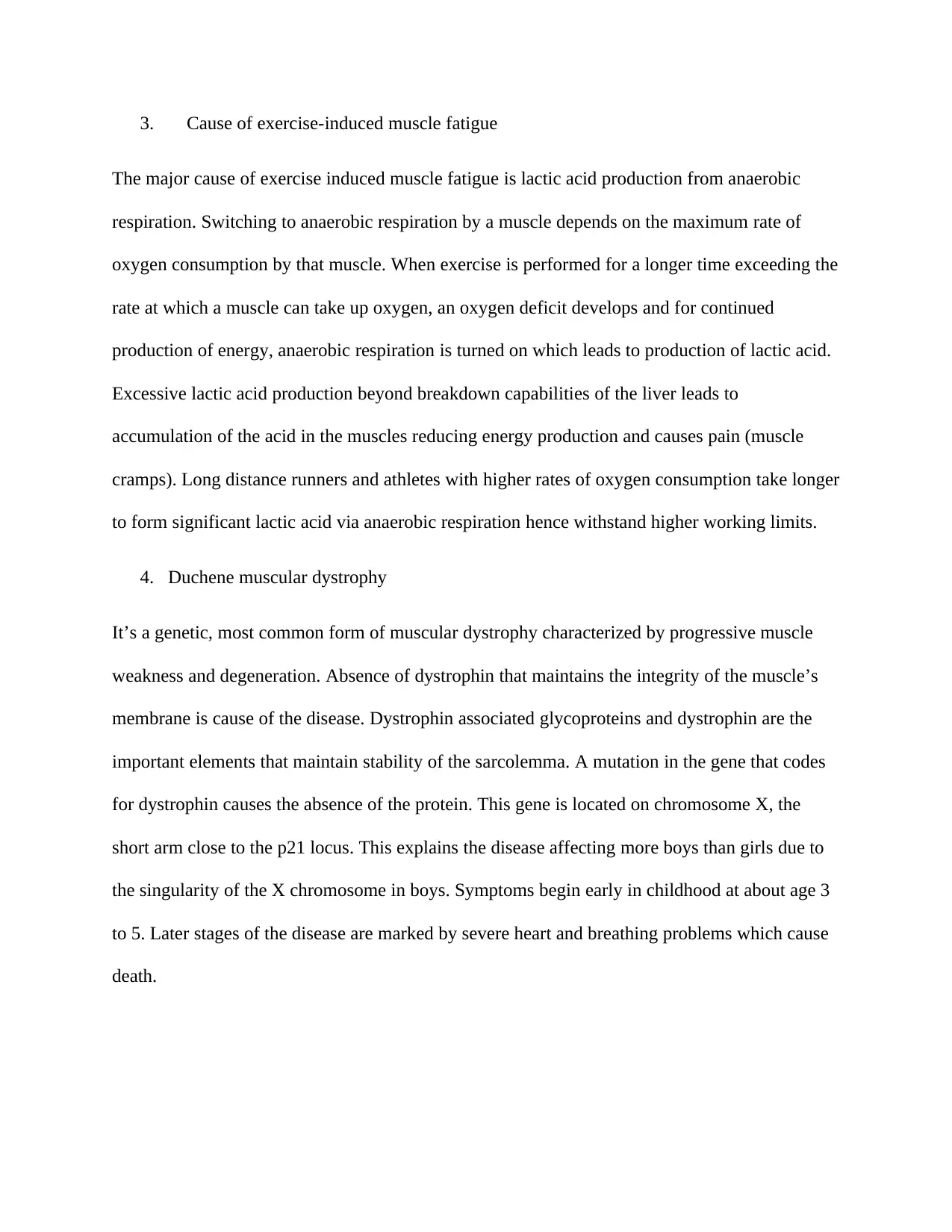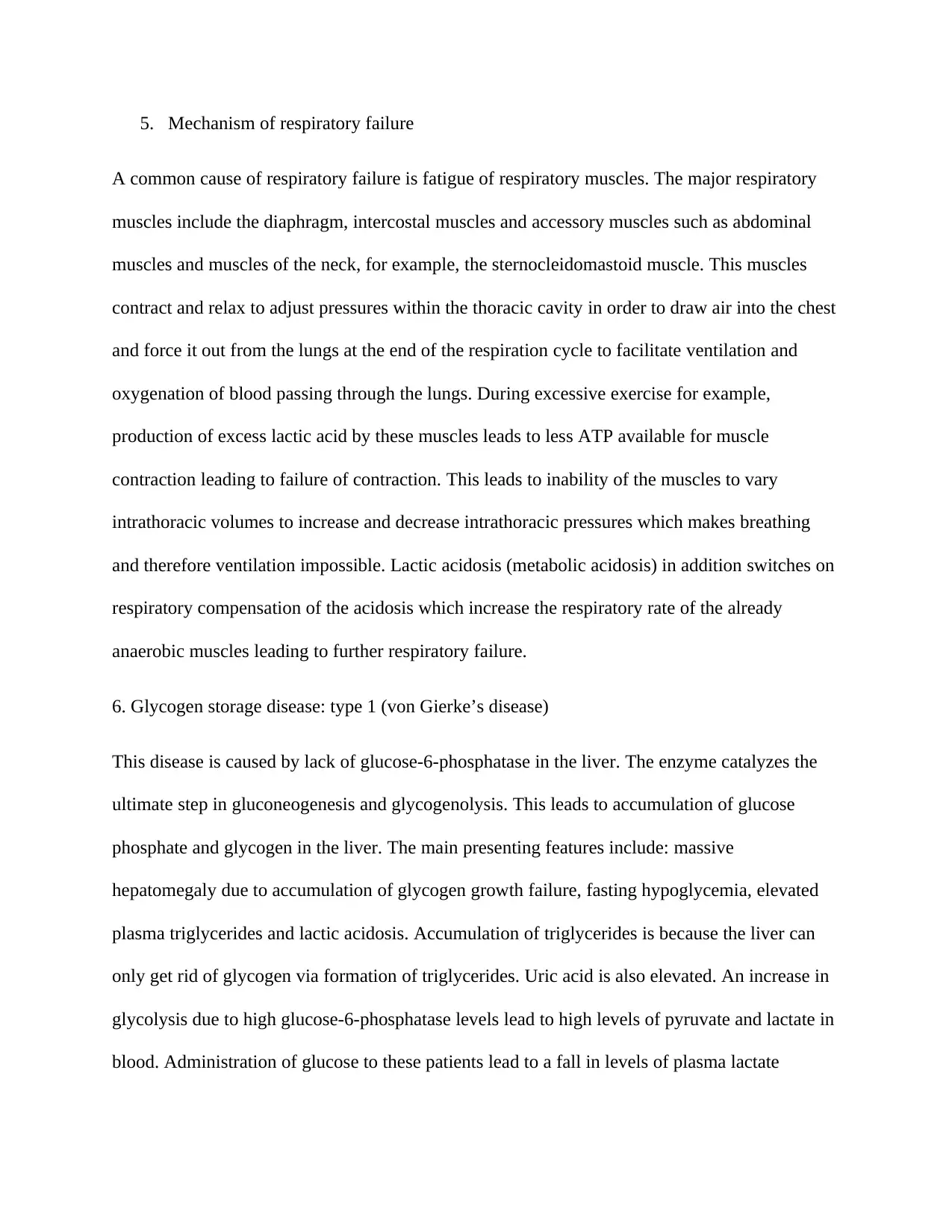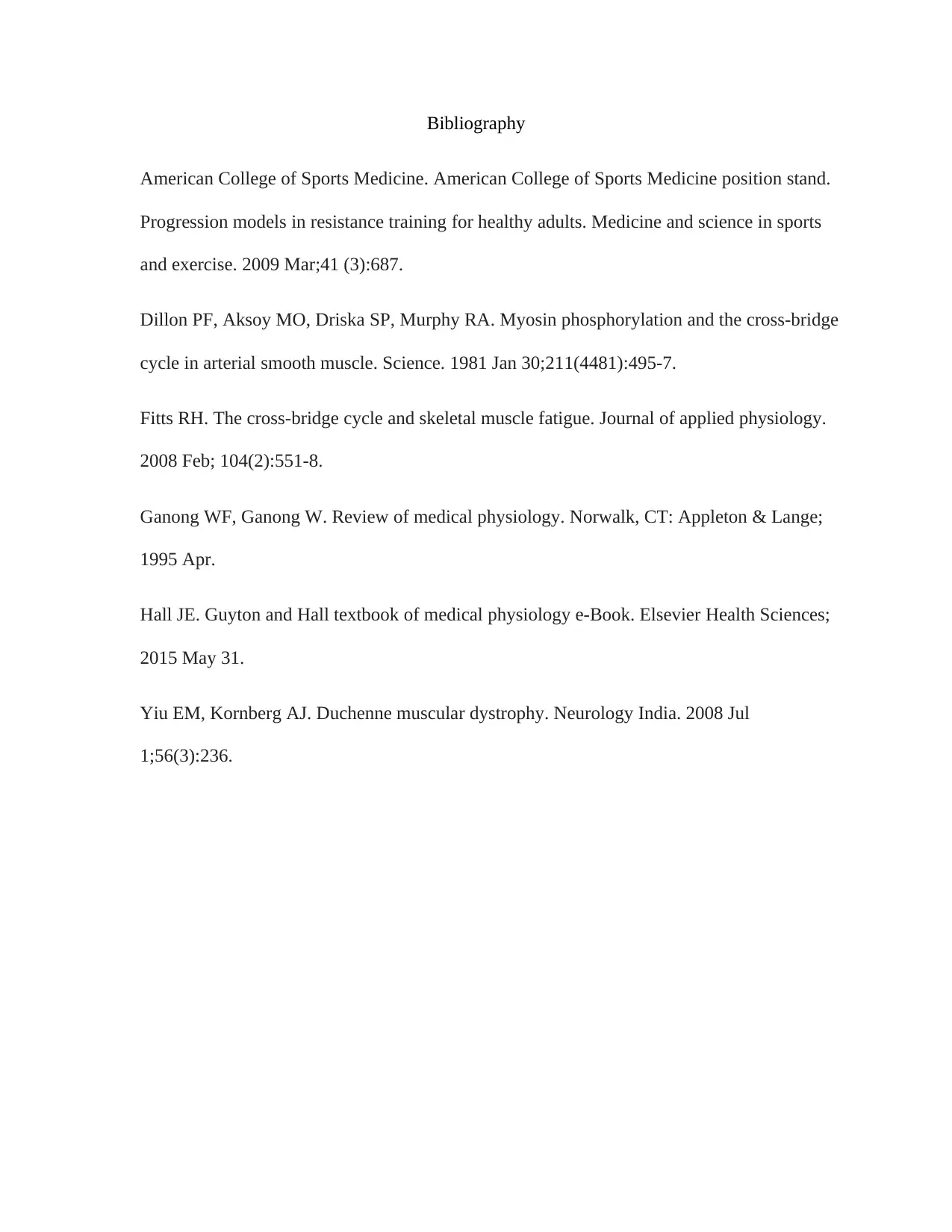UBC Pathology 521 Assignment: Muscle Function, Fatigue, and Diseases
VerifiedAdded on 2023/06/10
|5
|1070
|427
Homework Assignment
AI Summary
This assignment solution covers the mechanism of muscle contraction, muscle energetics, and fatigue, along with pathological conditions associated with muscle dysfunction. It explains the cross-bridge cycle, normalization of muscle force, shortening velocity, and power. The causes of exercise-induced muscle fatigue, focusing on lactic acid production, are discussed. Furthermore, the solution elaborates on Duchenne muscular dystrophy, its genetic basis, and symptoms. The mechanisms of respiratory failure, particularly concerning respiratory muscle fatigue, are detailed. Lastly, Glycogen storage disease type 1 (von Gierke’s disease) is explained, covering its enzymatic deficiency, clinical features, and management. The document references credible sources to support its explanations. Desklib provides more such solved assignments and study resources for students.

1. The cross bridge cycle
A cross bridge is formed by attachment of activated myosin to actin in the muscle cell. This is
the first step. Inorganic phosphate is then released strengthening the bond between actin and
myosin.
The second step is formation of a power stroke. This involves release of ADP which causes
activated myosin heads to pivot, hence sliding thin myofilaments to the sarcomere center.
Another ATP is then bound to the head of the myosin filament. This weakens the link between
the actin and myosin head. This causes the myosin head to detach and therefore, cross-bridge
detachment.
The last step is myosin head reactivation to the initial cocked position. This process requires
energy. The energy is obtained by hydrolysis of ATP to inorganic phosphate and ADP.
2. How and why muscle force, shortening velocity and power are normalized
The cross sectional area of the muscle normalizes the force produced by the muscle. This helps
in reduction of strain to the different muscle filaments. This also masks the differences in force
production between different muscle fibers. The resting length of the muscle normalizes the
velocity or length of the muscle. Each contractile unit has to contract less in a longer muscle
fiber to produce the same reduction in length that a shorter muscle produces with more
contraction. The volume or weight of a muscle normalizes the power produced. The more muscle
fibers (volume), the more powerful and resistant to tear they are. Lighter or low volume muscles
produce less power to match their combined tensile strength.
A cross bridge is formed by attachment of activated myosin to actin in the muscle cell. This is
the first step. Inorganic phosphate is then released strengthening the bond between actin and
myosin.
The second step is formation of a power stroke. This involves release of ADP which causes
activated myosin heads to pivot, hence sliding thin myofilaments to the sarcomere center.
Another ATP is then bound to the head of the myosin filament. This weakens the link between
the actin and myosin head. This causes the myosin head to detach and therefore, cross-bridge
detachment.
The last step is myosin head reactivation to the initial cocked position. This process requires
energy. The energy is obtained by hydrolysis of ATP to inorganic phosphate and ADP.
2. How and why muscle force, shortening velocity and power are normalized
The cross sectional area of the muscle normalizes the force produced by the muscle. This helps
in reduction of strain to the different muscle filaments. This also masks the differences in force
production between different muscle fibers. The resting length of the muscle normalizes the
velocity or length of the muscle. Each contractile unit has to contract less in a longer muscle
fiber to produce the same reduction in length that a shorter muscle produces with more
contraction. The volume or weight of a muscle normalizes the power produced. The more muscle
fibers (volume), the more powerful and resistant to tear they are. Lighter or low volume muscles
produce less power to match their combined tensile strength.
Paraphrase This Document
Need a fresh take? Get an instant paraphrase of this document with our AI Paraphraser

3. Cause of exercise-induced muscle fatigue
The major cause of exercise induced muscle fatigue is lactic acid production from anaerobic
respiration. Switching to anaerobic respiration by a muscle depends on the maximum rate of
oxygen consumption by that muscle. When exercise is performed for a longer time exceeding the
rate at which a muscle can take up oxygen, an oxygen deficit develops and for continued
production of energy, anaerobic respiration is turned on which leads to production of lactic acid.
Excessive lactic acid production beyond breakdown capabilities of the liver leads to
accumulation of the acid in the muscles reducing energy production and causes pain (muscle
cramps). Long distance runners and athletes with higher rates of oxygen consumption take longer
to form significant lactic acid via anaerobic respiration hence withstand higher working limits.
4. Duchene muscular dystrophy
It’s a genetic, most common form of muscular dystrophy characterized by progressive muscle
weakness and degeneration. Absence of dystrophin that maintains the integrity of the muscle’s
membrane is cause of the disease. Dystrophin associated glycoproteins and dystrophin are the
important elements that maintain stability of the sarcolemma. A mutation in the gene that codes
for dystrophin causes the absence of the protein. This gene is located on chromosome X, the
short arm close to the p21 locus. This explains the disease affecting more boys than girls due to
the singularity of the X chromosome in boys. Symptoms begin early in childhood at about age 3
to 5. Later stages of the disease are marked by severe heart and breathing problems which cause
death.
The major cause of exercise induced muscle fatigue is lactic acid production from anaerobic
respiration. Switching to anaerobic respiration by a muscle depends on the maximum rate of
oxygen consumption by that muscle. When exercise is performed for a longer time exceeding the
rate at which a muscle can take up oxygen, an oxygen deficit develops and for continued
production of energy, anaerobic respiration is turned on which leads to production of lactic acid.
Excessive lactic acid production beyond breakdown capabilities of the liver leads to
accumulation of the acid in the muscles reducing energy production and causes pain (muscle
cramps). Long distance runners and athletes with higher rates of oxygen consumption take longer
to form significant lactic acid via anaerobic respiration hence withstand higher working limits.
4. Duchene muscular dystrophy
It’s a genetic, most common form of muscular dystrophy characterized by progressive muscle
weakness and degeneration. Absence of dystrophin that maintains the integrity of the muscle’s
membrane is cause of the disease. Dystrophin associated glycoproteins and dystrophin are the
important elements that maintain stability of the sarcolemma. A mutation in the gene that codes
for dystrophin causes the absence of the protein. This gene is located on chromosome X, the
short arm close to the p21 locus. This explains the disease affecting more boys than girls due to
the singularity of the X chromosome in boys. Symptoms begin early in childhood at about age 3
to 5. Later stages of the disease are marked by severe heart and breathing problems which cause
death.

5. Mechanism of respiratory failure
A common cause of respiratory failure is fatigue of respiratory muscles. The major respiratory
muscles include the diaphragm, intercostal muscles and accessory muscles such as abdominal
muscles and muscles of the neck, for example, the sternocleidomastoid muscle. This muscles
contract and relax to adjust pressures within the thoracic cavity in order to draw air into the chest
and force it out from the lungs at the end of the respiration cycle to facilitate ventilation and
oxygenation of blood passing through the lungs. During excessive exercise for example,
production of excess lactic acid by these muscles leads to less ATP available for muscle
contraction leading to failure of contraction. This leads to inability of the muscles to vary
intrathoracic volumes to increase and decrease intrathoracic pressures which makes breathing
and therefore ventilation impossible. Lactic acidosis (metabolic acidosis) in addition switches on
respiratory compensation of the acidosis which increase the respiratory rate of the already
anaerobic muscles leading to further respiratory failure.
6. Glycogen storage disease: type 1 (von Gierke’s disease)
This disease is caused by lack of glucose-6-phosphatase in the liver. The enzyme catalyzes the
ultimate step in gluconeogenesis and glycogenolysis. This leads to accumulation of glucose
phosphate and glycogen in the liver. The main presenting features include: massive
hepatomegaly due to accumulation of glycogen growth failure, fasting hypoglycemia, elevated
plasma triglycerides and lactic acidosis. Accumulation of triglycerides is because the liver can
only get rid of glycogen via formation of triglycerides. Uric acid is also elevated. An increase in
glycolysis due to high glucose-6-phosphatase levels lead to high levels of pyruvate and lactate in
blood. Administration of glucose to these patients lead to a fall in levels of plasma lactate
A common cause of respiratory failure is fatigue of respiratory muscles. The major respiratory
muscles include the diaphragm, intercostal muscles and accessory muscles such as abdominal
muscles and muscles of the neck, for example, the sternocleidomastoid muscle. This muscles
contract and relax to adjust pressures within the thoracic cavity in order to draw air into the chest
and force it out from the lungs at the end of the respiration cycle to facilitate ventilation and
oxygenation of blood passing through the lungs. During excessive exercise for example,
production of excess lactic acid by these muscles leads to less ATP available for muscle
contraction leading to failure of contraction. This leads to inability of the muscles to vary
intrathoracic volumes to increase and decrease intrathoracic pressures which makes breathing
and therefore ventilation impossible. Lactic acidosis (metabolic acidosis) in addition switches on
respiratory compensation of the acidosis which increase the respiratory rate of the already
anaerobic muscles leading to further respiratory failure.
6. Glycogen storage disease: type 1 (von Gierke’s disease)
This disease is caused by lack of glucose-6-phosphatase in the liver. The enzyme catalyzes the
ultimate step in gluconeogenesis and glycogenolysis. This leads to accumulation of glucose
phosphate and glycogen in the liver. The main presenting features include: massive
hepatomegaly due to accumulation of glycogen growth failure, fasting hypoglycemia, elevated
plasma triglycerides and lactic acidosis. Accumulation of triglycerides is because the liver can
only get rid of glycogen via formation of triglycerides. Uric acid is also elevated. An increase in
glycolysis due to high glucose-6-phosphatase levels lead to high levels of pyruvate and lactate in
blood. Administration of glucose to these patients lead to a fall in levels of plasma lactate
⊘ This is a preview!⊘
Do you want full access?
Subscribe today to unlock all pages.

Trusted by 1+ million students worldwide

through insulin-mediated glycogenolysis inhibition which is characteristic of this disease.
Nocturnal tube feeding improves stunted growth and hypoglycemic attacks.
Nocturnal tube feeding improves stunted growth and hypoglycemic attacks.
Paraphrase This Document
Need a fresh take? Get an instant paraphrase of this document with our AI Paraphraser

Bibliography
American College of Sports Medicine. American College of Sports Medicine position stand.
Progression models in resistance training for healthy adults. Medicine and science in sports
and exercise. 2009 Mar;41 (3):687.
Dillon PF, Aksoy MO, Driska SP, Murphy RA. Myosin phosphorylation and the cross-bridge
cycle in arterial smooth muscle. Science. 1981 Jan 30;211(4481):495-7.
Fitts RH. The cross-bridge cycle and skeletal muscle fatigue. Journal of applied physiology.
2008 Feb; 104(2):551-8.
Ganong WF, Ganong W. Review of medical physiology. Norwalk, CT: Appleton & Lange;
1995 Apr.
Hall JE. Guyton and Hall textbook of medical physiology e-Book. Elsevier Health Sciences;
2015 May 31.
Yiu EM, Kornberg AJ. Duchenne muscular dystrophy. Neurology India. 2008 Jul
1;56(3):236.
American College of Sports Medicine. American College of Sports Medicine position stand.
Progression models in resistance training for healthy adults. Medicine and science in sports
and exercise. 2009 Mar;41 (3):687.
Dillon PF, Aksoy MO, Driska SP, Murphy RA. Myosin phosphorylation and the cross-bridge
cycle in arterial smooth muscle. Science. 1981 Jan 30;211(4481):495-7.
Fitts RH. The cross-bridge cycle and skeletal muscle fatigue. Journal of applied physiology.
2008 Feb; 104(2):551-8.
Ganong WF, Ganong W. Review of medical physiology. Norwalk, CT: Appleton & Lange;
1995 Apr.
Hall JE. Guyton and Hall textbook of medical physiology e-Book. Elsevier Health Sciences;
2015 May 31.
Yiu EM, Kornberg AJ. Duchenne muscular dystrophy. Neurology India. 2008 Jul
1;56(3):236.
1 out of 5
Your All-in-One AI-Powered Toolkit for Academic Success.
+13062052269
info@desklib.com
Available 24*7 on WhatsApp / Email
![[object Object]](/_next/static/media/star-bottom.7253800d.svg)
Unlock your academic potential
Copyright © 2020–2025 A2Z Services. All Rights Reserved. Developed and managed by ZUCOL.


